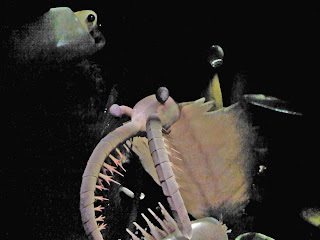 Santa's hair and long beard are white as snow. But as a boy, his hair was probably a different color. Just like boys the world over, his head would have been topped with shades of brown, red, or yellow.
Santa's hair and long beard are white as snow. But as a boy, his hair was probably a different color. Just like boys the world over, his head would have been topped with shades of brown, red, or yellow.Hair color originates inside the skin on the head, where hairs are attached. Pull on a hair firmly and slowly until it comes out, and you'll notice a small white tube clinging to the end of it. This tube is a clump of cells that fit inside a narrow hole in your scalp, a hair follicle. Hair grows in hair follicles, and the cells that line hair follicles supply the growing hair with color.
A hair grows as cells are added to its bottom. These cells contain a strong protein called keratin, which gives hair its structure. Fingernails are made of keratin too. As more and more cells rich in keratin are added to the bottom of the hair, the older cells are pushed higher in the follicle tube, towards the surface of the scalp. By the time a hair cell has been pushed through the entire follicle tube to the surface of the head, it is dead. Hair is not alive, which is why it does not hurt to cut it! The more cells that are added, the longer the hair grows.
In case you are wondering…Hair grows about 1 cm every month.
Hair does not keep growing and growing forever. Every two to seven years the follicle stops adding keratin cells. The hair stays attached for a few months and then it falls out. Every day,
As people get older, especially when they have lived for fifty years or more, the color cells start to disappear, and there is less melanin to transfer to the growing hairs. We are not sure why these cells disappear. For some people it happens slowly over many years. For other people it happens quickly. Hairs still keep growing, they just don’t have much color in them any more.
































 The program involves a dinner, tour of VIATEC, the Proteomics Lab, and the morning of October 25 on campus. At UVic, the students will attend workshops from 10 a.m. to 12:30 p.m. delivered by faculty and students. The programming for these workshops is arranged by Science Venture, under the guidance of Melisa Yestrau, director.
The program involves a dinner, tour of VIATEC, the Proteomics Lab, and the morning of October 25 on campus. At UVic, the students will attend workshops from 10 a.m. to 12:30 p.m. delivered by faculty and students. The programming for these workshops is arranged by Science Venture, under the guidance of Melisa Yestrau, director. The UVic presenters on Tuesday, Oct. 25 are: PhD candidate Veronika Irvine (Computer Science); senior lab instructor Duncan Johannessen (Earth & Ocean Sciences); Karl Makepeace (UVic Proteomics Centre); BSc student Stephanie Robertson (Engineering); PhD candidate Jenni Woodcock (Computer Science) as well as Drs. Stephanie Willerth (Biomedical Engineering) and Peter Wild of IESVic (Engineering).
The UVic presenters on Tuesday, Oct. 25 are: PhD candidate Veronika Irvine (Computer Science); senior lab instructor Duncan Johannessen (Earth & Ocean Sciences); Karl Makepeace (UVic Proteomics Centre); BSc student Stephanie Robertson (Engineering); PhD candidate Jenni Woodcock (Computer Science) as well as Drs. Stephanie Willerth (Biomedical Engineering) and Peter Wild of IESVic (Engineering).




